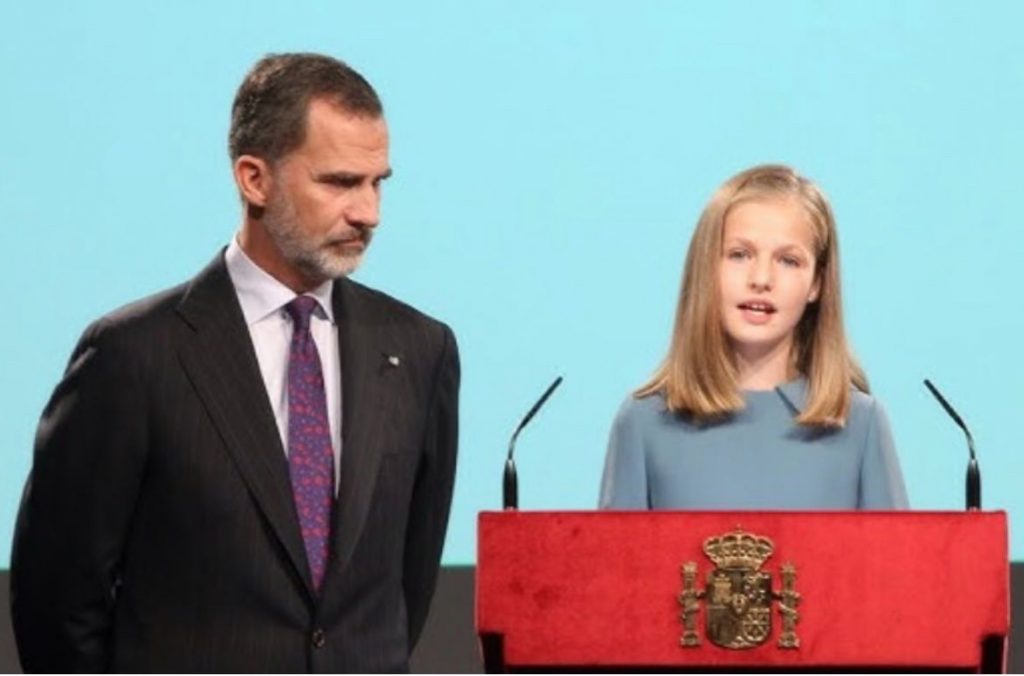No Feat Too High For This Princess or Simply Carving A Path To Excellence?
Published 31st October 2025 08:25 GMT
By Iona Yu

Image Credit: Pinterest Sergey Vincenzo
From the birth of civilisation’s modern era, you can count the number of women who have faced as much pressure from their earliest days of consciousness as this high achiever on one hand alone. And although you might think one such other female would have been her quite literally “great”, great-great-great grandmother Queen Victoria herself — the forebear to the founding fathers of the Commonwealth — Victoria did not have her fate set in stone upon whispering her first words, nor upon comprehending her first moral-infused children’s book. She was not destined to be the Queen & Empress she would later become until she was beyond 11 years and 1 month old.
Leonor, on the other hand, has lived an entirely different story. Her destiny has been written into the very architecture of her upbringing — an education not merely of intellect, but of poise, endurance, and public devotion. Thanks to her mother, former media anchor — but in reality, perhaps a former media general — behind that confident, supermodel-esque, now-trademark leftward-raised smile that has become second nature to her, Princess Leonor of Asturias and Girona has learned to navigate attention, expectation, and duty with the composure of someone twice her age.
By 13, while most children were still learning how to give classroom presentations, Leonor was already presenting national awards — shaking hands with Nobel laureates, scientists, and writers, her calm gaze reflecting the weight of centuries yet carrying it with the lightness of youth. It was the beginning of her public life, and since then she has only elevated her standing — one carefully measured step, one brilliantly executed gesture at a time.

(King Felipe VI of Spain watching his daughter, Princess Leonor, as she gives her first public speech. Image Credit: Newzee)
Now, at 20 years old, the Princess of Asturias stands as both symbol and substance — a young woman mastering her own myth. Her current chapter, one of physical grit and intellectual discipline, unfolds within the rigorous halls of Spain’s military academies. Few realise just how demanding her schedule has become: dawn marches through the crisp mountain air, field drills beneath the punishing sun, tactical exercises that test both strength and leadership — all performed with the same quiet determination she once brought to a podium. It is said that her instructors admire her discipline as much as her humility; that she runs rather than rides when others would have chosen comfort; that she insists on earning, not inheriting, respect.
Her studies continue in parallel — a rigorous blend of international law, political science, and environmental ethics — forming the intellectual scaffolding of a future queen capable not only of reigning but of reasoning, negotiating, and inspiring. Fluent in Spanish, English, French, Catalan, and now deepening her command of Arabic and Mandarin, Leonor is preparing herself for a century in which bridges between cultures will be the new instruments of power.
And what of the woman she is becoming? At twenty-five, when the world will undoubtedly gather once more to witness another milestone, she may well be standing at the helm of a further renewed faith in Spain’s constitutional monarchy — a monarchy not reborn through decree, but re-energised through character. By then, her generation’s optimism may find its most eloquent voice in her own — a young sovereign who has known the weight of duty, yet carried it with poise; who has walked among her peers not as an untouchable royal, but as a companion in effort, laughter, and purpose.
Perhaps she will celebrate that day surrounded by fellow cadets who once shared the mud, the rain, and the medals, men and women who remember her not for her title but for her courage under the same sky. By her side, her sister Infanta Sofía, the confidante and counterbalance who has matched her wit for wit since childhood, may stand as both familial warmth and the quiet echo of shared destiny. And somewhere in that radiant circle, one can imagine her parents — King Felipe VI and Queen Letizia — watching with the serene pride of mentors who have shaped an heir through modern wisdom and moral depth rather than protocol alone.
It is easy to envision that, by twenty-five, Leonor will not simply embody Spain’s continuity but its renewal — the living proof that excellence, when nurtured through humility, can transcend lineage. The woman she is becoming seems destined not just to reign, but to lead a generation — disciplined by her military service, refined by her studies, and defined by an unshakable sense of purpose — into a new era where monarchy and modernity meet as partners in national aspiration.
And yet, one cannot help but wonder: what kind of man could walk beside such a woman? One who understands that her strength does not seek to overshadow but to inspire; who recognises that standing beside her means sharing, not bearing, the crown’s invisible weight. Will he be drawn from her world of discipline and duty — perhaps a fellow cadet who once marched at her pace beneath the same unforgiving sun — or from the spheres of culture, diplomacy, or science that reflect her intellectual curiosity and moral depth? Whoever he may be, he will need to match not her title, but her temperament — a rare balance of humility, courage, and vision — for only such a partner could stand beside a queen whose reign promises to be as graceful as it is groundbreaking, and as human as it is historic.
No one can yet say. But one thing is certain: the young woman who once pinned medals to others’ chests will, by then, have earned her own — not just in ceremony, but in character.
Princess Leonor of Spain is more than a royal heir. She is a study in cultivated excellence — a living testament to what happens when legacy meets merit, when duty is embraced not as burden but as destiny. For her, there appears to be no feat too high. She is not merely carving a path to excellence; she is redefining what the summit itself means.
